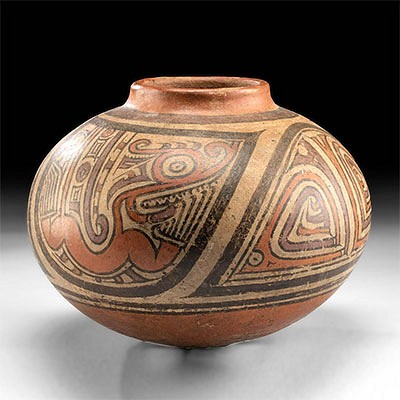Mid 20th C. Bamana Wood Chi Wara - Female w/ Baby
Lot 152
About Seller
Artemis Gallery
686 S Taylor Ave, Ste 106
Louisville, CO 80027
United States
Selling antiquities, ancient and ethnographic art online since 1993, Artemis Gallery specializes in Classical Antiquities (Egyptian, Greek, Roman, Near Eastern), Asian, Pre-Columbian, African / Tribal / Oceanographic art. Our extensive inventory includes pottery, stone, metal, wood, glass and textil...Read more
Estimate:
$1,400 - $2,100
Absentee vs Live bid
Two ways to bid:
- Leave a max absentee bid and the platform will bid on your behalf up to your maximum bid during the live auction.
- Bid live during the auction and your bids will be submitted real-time to the auctioneer.
Bid Increments
| Price | Bid Increment |
|---|---|
| $0 | $25 |
| $300 | $50 |
| $1,000 | $100 |
| $2,000 | $250 |
| $5,000 | $500 |
| $10,000 | $1,000 |
| $20,000 | $2,500 |
| $50,000 | $5,000 |
| $100,000 | $10,000 |
| $200,000 | $20,000 |
About Auction
By Artemis Gallery
Apr 15, 2021
Set Reminder
2021-04-15 10:00:00
2021-04-15 10:00:00
America/New_York
Bidsquare
Bidsquare : VARIETY SALE | Ancient & Ethnographic Art
https://www.bidsquare.com/auctions/artemis-gallery/variety-sale-ancient-ethnographic-art-6811
Featuring classical antiquities, ancient and ethnographic art from cultures encompassing the globe. Egyptian, Greek, Roman, Etruscan, Near Eastern, Asian, Pre-Columbian, Native American, African / Tribal, Oceanic, Spanish Colonial, Russian, Fossils, Fine Art, more! Artemis Gallery info@artemisgallery.com
Featuring classical antiquities, ancient and ethnographic art from cultures encompassing the globe. Egyptian, Greek, Roman, Etruscan, Near Eastern, Asian, Pre-Columbian, Native American, African / Tribal, Oceanic, Spanish Colonial, Russian, Fossils, Fine Art, more! Artemis Gallery info@artemisgallery.com
- Lot Description
West Africa, Mali, Bamana (also Bambara), Mali, ca. 1950. A finely carved female Chi Wara (Ci Wara) headdress depicting a mother and child antelope, so skillfully and extensively carved with an intricate composition and marvelous incised details. In addition, the mother antelope is further embellished with five decorative embossed metal sheet cuffs around her horns and just below her eyes as well as red fiber tassels adorning her nose and eyes. The female figure carries a young antelope on her back - a composition that is thought to represent the Chi Wara hero carrying human beings, akin to a newborn on its mother's back. Size: 11.375" L x 2.375" W x 37.375" H (28.9 cm x 6 cm x 94.9 cm)
Often described as an antelope, the Chi Wara is actually a composite animal – part antelope, part aardvark, and part pangolin. All of these animals are creatures that dig up the earth; while antelopes carve the ground with their hooves, the aardvark and pangolin use their claws to excavate termite mounds. This communion with the earth makes them ideal components of the Chi Wara, the supernatural being believed to have taught the Bamana people how to farm.
Historically, such masks were worn by male and female pairs in a dance performance that praised skilled farmers. The creator of this particular mask emphasized the elongated body of a roan antelope; the vertical horns resemble those of both the roan and oryx antelopes and are also said to resemble millet stalks. The body, with its big ears and short legs, suggests the aardvark; while the incised surfaces suggest the scales of the pangolin. The dancer for whom such masks are intended, traditionally wears raffia stalks that symbolize flowing water as well as a fruitful harvest. The zig-zag motifs reference the sun's movement across the sky. A bold and breathtaking mask that demonstrates a high level of skill with its expert carving and overall beautiful composition.
This example is very similar to a female Chi Wara headdress in the Metropolitan Museum of Art (accession number 1978.412.436). According to the Met's essay, "Among the Bamana, oral traditions credit a mythical being named Ci Wara, a divine being half mortal and half animal, with the introduction of agriculture to the Bamana. Bamana society is primarily an agricultural one; even today the majority of Bamana peoples are subsistence farmers. These headdresses, also called ci wara, are carved to honor that original mythical being. Under Ci Wara's guidance, humans first learned to cultivate the land and became prosperous and able farmers. When humans gradually became careless and wasteful, however, Ci Wara is said to have buried himself in the earth. To honor Ci Wara's memory, the Bamana created a boli, a power object in which his spirit could reside, and carved headdresses such as these to represent him."
Provenance: private Houston, Texas, USA collection, purchased in Houston, Texas, USA in 1995
All items legal to buy/sell under U.S. Statute covering cultural patrimony Code 2600, CHAPTER 14, and are guaranteed to be as described or your money back.
A Certificate of Authenticity will accompany all winning bids.
We ship worldwide and handle all shipping in-house for your convenience.
#162914Repair to young antelope with break across the neckline as shown; the reattached section could be better secured. Expected surface wear with scuffs, abrasions, nicks/chips to peripheries and high pointed areas. Perforation through base likely intended for attachment.Condition
- Shipping Info
-
All shipping is handled in-house for your convenience. Your invoice from Artemis Gallery will include shipping calculation instructions. If in doubt, please inquire BEFORE bidding for estimated shipping costs for individual items.
-
- Buyer's Premium



 EUR
EUR CAD
CAD AUD
AUD GBP
GBP MXN
MXN HKD
HKD CNY
CNY MYR
MYR SEK
SEK SGD
SGD CHF
CHF THB
THB













